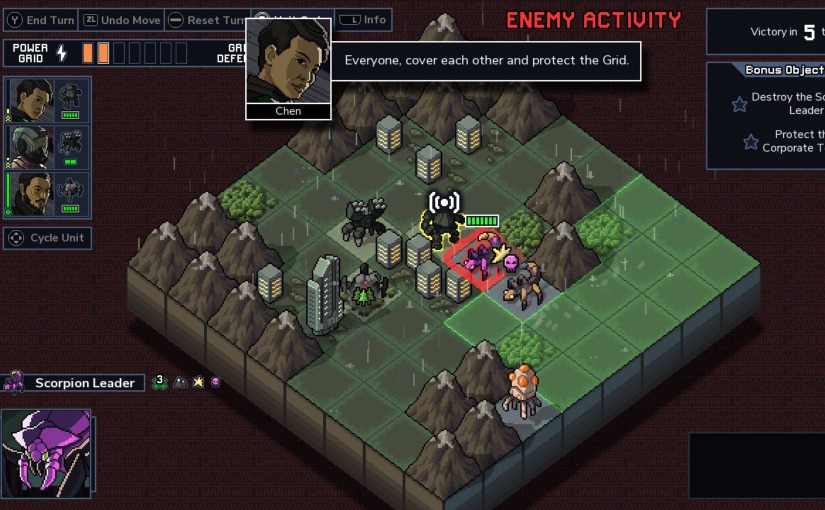Live, Kill Kaiju, Die, Repeat
As someone who’s eyes light up at the sight of a grid-based battlefield populated with adorable 2D combatants, I was predisposed to give Into the Breach a chance. If you’re not like me, and don’t instantly fall in love with anything that bears even a passing resemblance to Shining Force III or Final Fantasy Tactics, you might glance at the relatively small battlefields and limited number of units on show and decide to give this one a miss. I’m here to politely request that you reconsider that decision, as you’re missing out on a gem! A bastard-hard and thoroughly depressing gem, but a gem nonetheless.
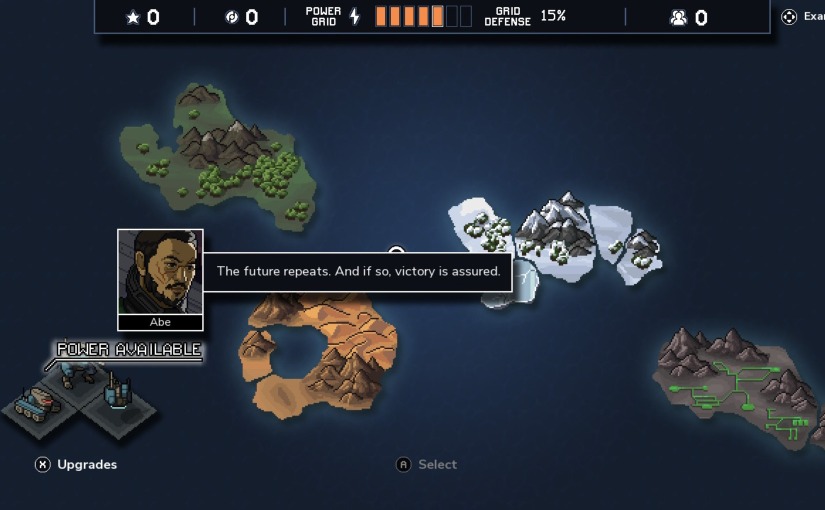
This indie-developed, mech-on-kaiju strategy game has been around since 2018, but I recently picked up the physical copy on Switch, and have found myself thoroughly absorbed into its time-bending, apocalyptic world. Your job in Into the Breach is to command a small squad of mechs as they attempt to defend the world’s population and infrastructure from an onslaught of giant bugs known as the Vek. Already on its last legs due to various natural catastrophes, civilisation has been brought to the brink of destruction by the marauding kaiju, and humanity’s last hope comes in the form of a group of time-hopping mech pilots.
The main aim of the game is to protect buildings and facilities from monster attacks, as these locations provide power to your power grid, and if your power grid fails, the timeline you’re in is fucked and it’s time to bail out. If this happens, your pilots will use their timey-wimey powers to zap themselves to a different timeline and try again. Each pilot is scattered across different timelines, too, so you can only keep one of them, and if you mess up and one of your mechs gets destroyed, the pilot is (usually) gone for good. Just don’t get too attached to these guys, okay?
While Into the Breach has a lot of the gameplay and strategy you’d expect from comparable modern retro tactical games like Triangle Strategy and Wargroove, there are a few mechanics that handily set it apart. One is the previously-mentioned timeline shenanigans, which lends itself to roguelike-style progression where repeated failures result in you being slightly better-equipped to take on the next timeline. Another mechanic that sets Into the Breach apart is the fact that it will clearly tell you exactly what the monstrous Vek are planning to do in the next turn, and will allow you to plan and manipulate them appropriately.
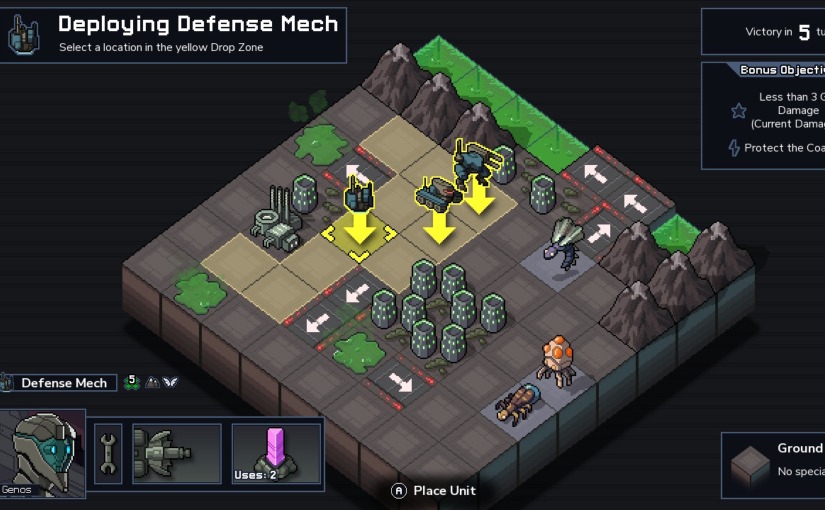
It may sound like being able to accurately predict the AI’s every move would make a game like this pretty easy, but this is not the case. In fact, it’s this mechanic that takes Into the Breach further into board game or puzzle game territory. This removal of random chance or behind-the-scenes calculations makes Into the Breach pure strategy, akin to Chess, and will lead to difficult decisions aplenty. Expect to find yourself staring at the screen for minutes on end, sighing and rubbing your chin as you attempt to run through sequences of moves in your head to get out of a seemingly impossible situation you’ve found yourself in. You’ll often find yourself played into a corner where you’re forced to sacrifice something, and making the difficult choice between the mission objective or one of your experienced pilots is sure to produce lots of curse words and require a cup of tea or two. You’ll need a strong stomach, thick skin, and a really, really big brain to master this one.
The final goal of the game is to defeat the Vek at their hive, which is an area that opens up after liberating two of the four available islands. The difficulty scales as you progress through the islands, so taking the Vek hive out after island number two is your easiest option, but successfully completing a four-island run is a much more difficult goal. It’s a tough ask, and only letting you take one pilot with you to the next timeline feels harsh to the point of being insurmountable. Perseverance, experimentation, and the ability to stay calm and look for options under pressure are your best weapons to get there.
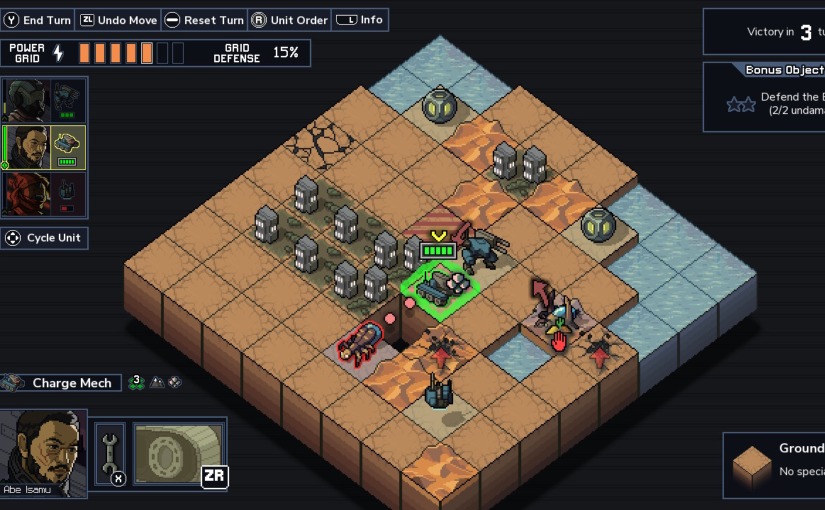
Once you’re up and running, understanding and upgrading your mech’s abilities, manipulating the Vek into harming each other, and successfully shielding civilians from kaiju attack becomes extremely satisfying. You’ll feel like a legendary commander when you pull it off, and you’ll become more confident as you start to understand the game’s way of thinking. However, Into the Breach is always capable of surprising you, and a power grid failure that results in hordes of titanic bugs burrowing out of the Earth’s crust to overwhelm the planet’s last defenders is always only a mistake away.
As alluded to earlier, Into the Breach can initially seem limited. The maps are small, you’re usually in charge of only three units at a time, and there are only five different environment types to do battle in. However, its difficulty, ingenious mechanics, variety of environmental effects and open-ended nature make for an incredibly deep experience that will keep throwing up new problems for as long as you’re willing to solve them.
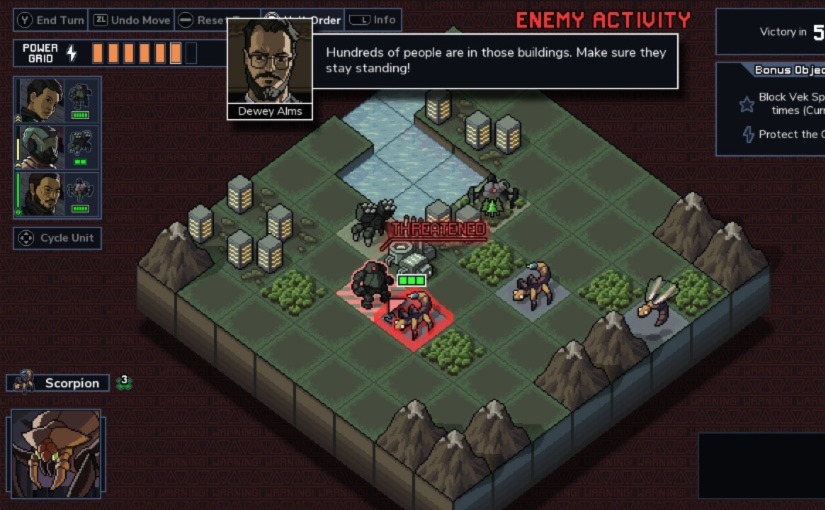
Tough, tense, and hugely atmospheric, Into the Breach is a strategy game for big time players. Great pixel art and some fantastically appropriate musical pieces all add to a high quality strategy experience, with unlockable mech squads and pilots, and additional, advanced options allowing experienced players to tweak gameplay to their heart’s content.
Climb into your mech, steel yourself for the horrors you’re about to witness, and give this strategy gem the chance it deserves. After all, you can always abandon this timeline and jump to the next if things don’t work out.
Played on Switch

